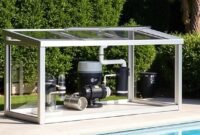If you love swimming, having a private pool inside your house is great. Imagine you don’t have to go community pool when you are stuck with work hectic – you only need to go home, turn to a swim outfit, and get the splash.
However, new pool owners are usually puzzled about how to cleanse and disinfect the pool. We know that bleach can work on it, but how much bleach to add to the pool appropriately?
How Much Bleach to Add to the Pool
Bleach is not merely a product to whiten your clothes – nor a product only to wipe away the ink smudge marks on your clothing. If you don’t know bleach, it is more than that. It is a versatile product in both domestic and industrial works.
This mix of sodium, chlorine, and oxygen elements nails it when it comes to disinfection. That is why people are using it to disinfect their pools.
In general, bleaches have a broad spectrum of bactericidal features. That means that most bacteria are affected by bleach (also known as sodium hypochlorite). Not only bacteria but sodium hypochlorite also plays a role in eradicating most algae and viruses, making the pool safe for swimming.

Well, let’s get into the topic:
How much bleach to use in pool? To answer this question, you need to know first the volume of your pool.
It is easy to calculate the volume of your rectangular pool. Check out the steps below.
- If you own a:
- Classic rectangular pool, you can count the volume by measuring the length, width, and depth. Then, multiply them all together.
- Circular pool, measure the diameter and depth. Then multiply the depth by the diameter square (d2) and 3.14, and divide it by four.
- Irregular shapes, You can break their shape into several regular shapes. Then count the volume of each regular shape and add it up.
- Then, to know how much bleach to add to the pool, you need to turn your findings into a gallon volumetric unit.
- Usually, per 100 gallons of water, you must add 1/8 cup of bleach. To count your bleach need, you need to divide the volume (in a gallon) by 100, then multiply that by 1/8. For instance, you have 300 gallons as your finding. The bleach you’ll need equals 300:100×1/8 = 3/8 cups of bleach.
Read also: Alkalinity VS PH in Swimming Pool
To ensure the safety of your swimming experience, it is crucial to maintain the chlorine levels in your pool. Utilizing a reliable chlorine test or a comprehensive test kit can help you monitor the pool chlorine concentration effectively. Remember, the pool water should ideally contain chlorine levels of 1-3 parts per million (ppm) to prevent the growth of harmful microorganisms.
If you have a larger pool, say 10,000 gallons, you’ll need to add chlorine accordingly to maintain the recommended concentration. Bleach is a cost-effective chlorine form and popular choice among pool owners. When bleach is added to pool water, it forms hypochlorous acid, which is the active component responsible for disinfection.
For those considering using liquid chlorine, it’s important to note that it typically comes in bottles of bleach and is a more concentrated source of chlorine. This makes it a convenient option for adjusting the chlorine levels in your pool.
How Much Bleach to Add to Kiddie Pool
If you only have a kiddie pool, or you are probably planning to build a kiddie pool, the trick for counting how much bleach to use in the pool is similar. The thumb rule is to count the volume of water you are entering the pool.
Let’s say your kiddie pool is a circular one with a diameter of 4 ft and 2 ft in depth. The counting will be 3.14 x 42 x 2: 4 = 25.12 ft cubic. Then, to turn it into volume in gallons, multiply that number by 7.48; hence, it is ~188 gallons.
To count how much bleach you need to add, remember that bleach measurement: 1/8 cup of bleach per 100 gallons of water. To ease your counting, you can round 188 gallons to 200 gallons, which means you’ll need two times 1/8 cup, which is ¼ cup of bleach.
How Much Liquid Bleach to Add to the Pool
In general, liquid bleach usually contains around 5.25% – 6.00% sodium hypochlorite – the active ingredient of bleach. The aforementioned counting was based on this, too, so you don’t need to find the other resources again to count how much bleach to use in the pool. However, you may be confused about how much liquid bleach equals a cup.
A cup is equal to 240 milliliters. Hence, if you are talking about counting a hundred-gallon liquid bleach measurement, it will make 1/8 cup bleach equal to 30 milliliters. For liquid measures, 30 milliliters equal to 2 tablespoons (US measures).
It is also important to remember that the higher the bleach concentration used, the smaller the amount one should add to the swimming pool. The counting between chlorine granules, liquid bleach, and calcium hypochlorite to disinfect your swimming pool is also different.
How Often Should I Add Bleach to My Pool?
Several factors contribute to the frequency with which bleach is added. Those factors are mentioned below.
- How many hours does your pool get sunshine, and how high is the UV value
The chlorine in sodium hypochlorite tends to be degraded on hotter days, especially if the UV value is higher. Therefore, you may add bleach more often to your swimming pool on summer days.
- Hours of swimming per day
The more hours the swimming pool gets occupied, the more your pool needs bleach added.
- Living things around
Is there a tree and insects nearby? If your pool is close to a tree or is often visited by animal swimmers, it’s time to set more alarms to add the bleach. The reason is, that living things like insects and falling leaves may bring bacteria and dirt.
That’s what you should know about how much bleach to use in the pool. It is important not to overdo it and not to provide too low a bleach concentration to your pool.


